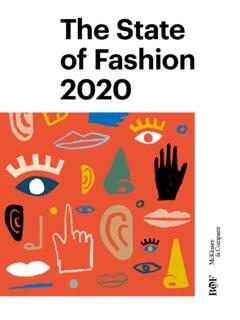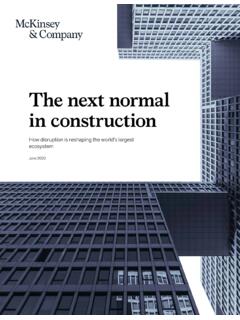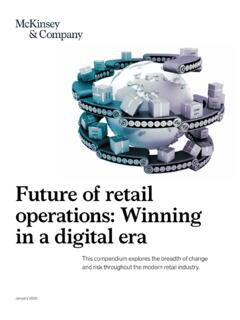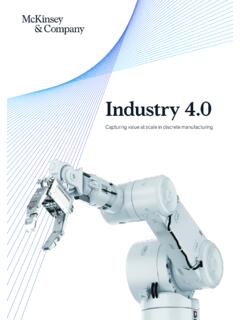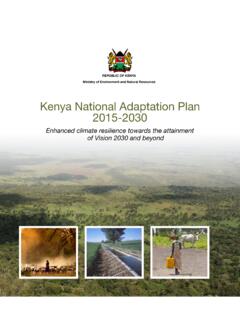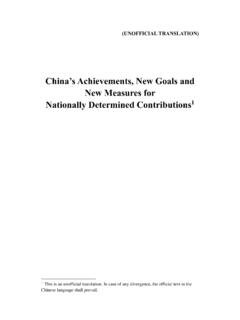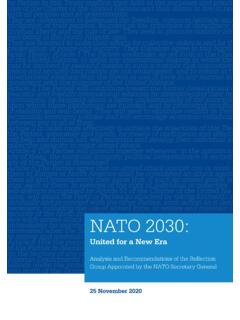Transcription of FASHION ON CLIMATE - McKinsey & Company
1 FASHION ONCLIMATEHOW THE FASHION INDUSTRY CAN URGENTLY ACT TO REDUCE ITS GREENHOUSE GAS EMISSIONSIMPRINTThis report is authored by McKinsey & Company ( McKinsey ) in partnership with Global FASHION Agenda (GFA). Through a multi-year strategic knowledge partnership, Global FASHION Agenda and McKinsey aim to present research and a fact base on the priorities of the CEO Agenda and to guide and mobilise FASHION executives in taking bold action on BYAUTHORS: Achim Berg and Karl-Hendrik Magnus are Senior Partners and leaders of McKinsey & Company s Global Apparel, FASHION & Luxury practice Sara Kappelmark is a partner in the Apparel, FASHION & Luxury practice.
2 Anna Granskog is a Partner, Libbi Lee and Corinne Sawers are Associate Partners and Poorni Polgampola an Engagement Manager in McKinsey & Company s Global Sustainability Lehmann is Chief Sustainability Officer at Global FASHION Agenda, where Holly Syrett is Senior Sustainability Manager and Gizem Arici is Sustainability : David WiganART DIRECTOR: Thomas Blanksch nGRAPHIC DESIGN: Daniel Siim 2020 copyright McKinsey & Company and Global FASHION AgendaIMPRINTAll rights reserved. Reproduction is strictly prohibited without prior written permission from the authors.
3 Every effort has been made to trace the copyright holders for this publication. Should any copyright holders have been inadvertently overlooked, McKinsey & Company and Global FASHION Agenda will make the necessary GLOBAL FASHION AGENDAG lobal FASHION Agenda is the foremost thought leadership and advocacy forum for industry collaboration and public-private cooperation on sustainability in FASHION . The non-profit organisation is on a mission to mobilise and guide the FASHION industry to take bold and urgent action on sustainability. Global FASHION Agenda is behind yearly guidelines, reports such as the CEO Agenda and the leading business event on sustainability in FASHION , Copenhagen FASHION Summit, which has been spearheading the movement for over a McKinsey & COMPANYMcKinsey & Company is a global management consulting firm deeply committed to helping institutions in the private, public and social sectors achieve lasting success.
4 McKinsey supports clients in FASHION and beyond on a wide range of sustainability related themes with a strong impact orientation. This ranges from executing broader sustainability transformation programmes to more targeted efforts on decarbonisation, circular business models and sustainable packaging. McKinsey & Company is a Strategic Knowledge Partner to GFA, with the joint aim to accelerate the pace and impact of the FASHION industry s transformation towards authors would like to thank all of those who contributed to this publication.
5 Special thanks go to Global FASHION Agenda s Strategic and Associate Partners, as well as the industry experts and the broader FASHION community who have contributed their time, insight and expertise to this report. We would also like to thank David Schmelzeisen and Amrei Becker from the Institut f r Textiltechnik, RWTH Aachen University. We extend our thanks to several McKinsey & Company colleagues for their contributions to this report: Victoria Benbassat, Anja B hner-Blaschke, Adriana Clemens, Michel Foucaurt, Eric Hannon, Kimberly Henderson, Saskia Hedrich, Kristen Jennings, Nimalan M, Mihael Maljak, Tomas Naucl r, Althea Peng, Mohammed Rahamatulla, Cristina Schaub, Ewa Sikora, Marie Strawczynski, Heidi Van Dyck, Jan Vlcek, Daan Walter, Jop Weterings, Annikka Wong, Waris Global FASHION Agenda, we extend our thanks for their contributions, to.
6 Eva Kruse, Thomas Tochtermann, Kerry Huang, Marie Louise Wedel Bruun, Molly Polk Hannon, Cleshawn Montague, Maria Luisa Martinez and Beatrice Perlman 02 EXECUTIVE SUMMARY 03 BASELINING THE FASHION INDUSTRY S GHG EMISSIONS 05 THE INDUSTRY S ACCELERATED ABATEMENT POTENTIAL 08 THE ECONOMICS OF EMISSIONS ABATEMENT 17 ROLES OF ECOSYSTEM ACTORS TO REACH THE PATHWAY 22 APPENDIX: METHODOLOGY AND ENDNOTES 2701 52 PREFACEWhen COVID-19 erupted this year, it highlighted the interconnectedness of our lives and the inherent uncertainty surrounding global economies, businesses and humankind.
7 Similarly, the protests associated with the Black Lives Matter movement have increased the pressure to solve social issues that pervade large parts of society and the FASHION industry. This turbulent year has heightened awareness of the many challenges the FASHION industry is facing, including in supplier relationships, greenhouse gas (GHG) emissions, employment structures, overproduction and wastage. These systemic issues are also apparent in the looming threat of CLIMATE change, which is set to create accelerating socioeconomic impacts over the coming years.
8 If we fail to take coordinated action on the greenhouse gas (GHG) emissions causing CLIMATE change, we can expect to see increasingly common crises such as heatwaves, rising sea levels and damage to ecosystems that are vital to our year marks a milestone in the industry s journey to restrict global warming to the degress targeted by the Paris CLIMATE Change To date, only around 50 FASHION companies have committed to the science-based targets aligned with the , 3As a significant contributor to CLIMATE change, the FASHION industry needs to act now to cut its GHG The onus is on FASHION leaders to move from a moderate decarbonisation trajectory to a significantly more ambitious one.
9 With that challenge in mind, it has never been more important to explore the emissions status quo and to understand in detail how various decarbonisation scenarios may play report presents an analysis on the FASHION industry s GHG emissions and outlines areas in which players can focus their efforts to meet CLIMATE targets. By triangulating GHG emissions data, analysing current and accelerated trajectories, and quantifying the gap to meeting the Paris targets, it offers insight into the industry s potential for decarbonisation and presents recommendations for moving report addresses stakeholders that include brands, retailers, manufacturers, citizens, investors, and policy makers to play their part in putting the FASHION industry on the pathway.
10 Only by daring to change, collaborate and embrace new ways of operating can we, together, transform the industry and create prosperity for people and communities while working within planetary boundaries, protecting biodiversity and minimising the industry s contribution to global 52 TWO THIRDS OF CONSUMERS SAY IT HAS BECOME EVEN MORE IMPORTANT TO LIMIT CLIMATE CHANGE FOLLOWING COVID-19. 5 RISING EXPECTATIONS ON SUSTAINABILITYCOVID-19 is having a significant effect on the FASHION industry, disrupting value chains, closing many of the world s retail outlets and creating a new level of public awareness over health, safety and the fragility of the planet.



